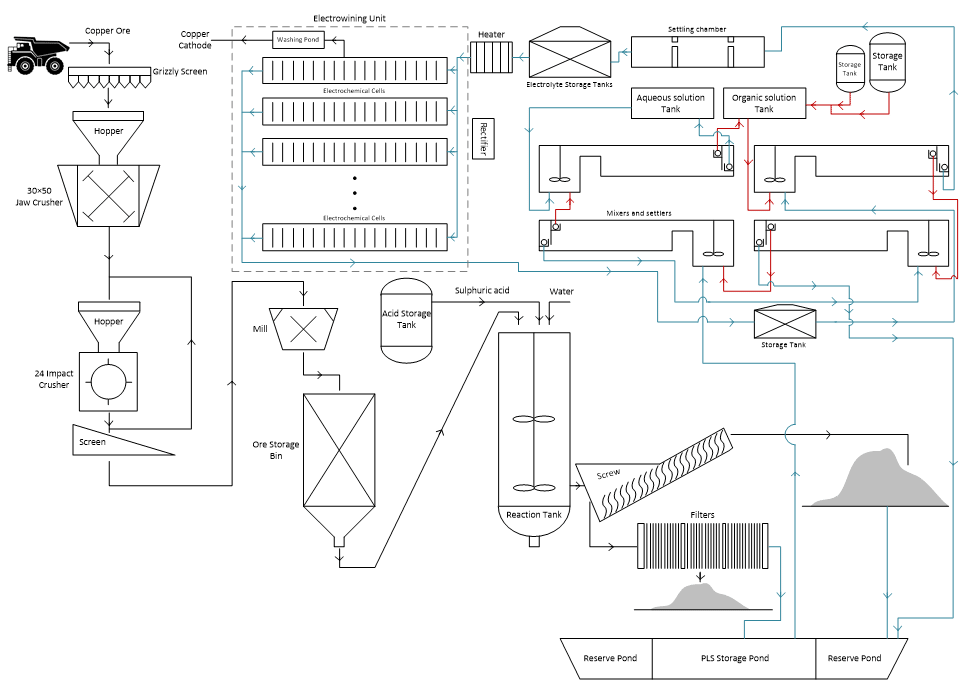Copper cathode hydrometallurgical production (L-SX-EW)
Introduction
Iran is rich in copper minerals from Southeast to North West of the country. Due to many applications of copper and its alloys especially in electrical industry, copper extraction is technically and economically feasible from mines with only 0.5% copper. Using hydrometallurgical processes with low environmental pollution for copper oxide ores is common in the world. More than 45% of world produced copper is used in electrical industries. Bronze and brass are the main copper alloys which have hardness, corrosion resistance and expansion ability.
Songoon, Sarcheshmeh, Ghale zari, Meydook etc. and many other oxide scattered mines along with big domestic and global market are Iran’s advantages for develop copper mining and processing.
Aramico as a knowledge based company in metallurgy and mining industries is has been doing a lot of researches in copper mining and processing especially by hydrometallurgical routs. Aramico has developed a copper cathode pilot plant that produces copper cathode by leaching, solvent extraction and Electrowinning.

Application
Copper as an applicable metal used in electrical industry (wire and cable, tube and metal strip, hardware and digital equipment and electrical circuits), Construction industry (tube and pipe, valve and siphon, gates and fittings, thick sheets, cooling and heating equipment and etc.), transportation industries (wire, cable and tube, pump and its parts and electric cars), alloying (brass and bronze), medical industry and etc.
Process
Concentration, pyro-metallurgy, and electro-refining processes account for about 80% of primary copper production. The remaining 20% of primary copper production comes from hydrometallurgical processing of mainly copper oxide and chalcocite ores. This copper is recovered by leaching, followed by solvent extraction and Electrowinning. The final product is electrowon cathode copper, which is equal to or often greater in purity than electro-refined copper.
Leaching involves dissolving Cu2+ (or Cu+) from copper-containing minerals into an aqueous H2SO4 solution, known as the lixiviant, to produce a pregnant leach solution (PLS). In addition to copper, the PLS will also contain other impurity species, such as Fe, Al, Co, Mn, Zn, Mg, Ca, etc., that may be present in the ore and are leached with the copper. The leach residue (solids remaining after leaching) contains gangue or waste minerals, such as alumina, silica, and insoluble iron oxides/hydroxides/sulfates. The gangue is disposed of in tailings dams or dumps. The PLS is fed to the solvent-extraction circuit.
Solvent extraction (SX) treats the impure PLS to purify and upgrade the solution to produce an electrolyte suitable for electro-winning of copper. In the extraction step, copper is selectively loaded into an organic solvent which contains an extractant that reacts selectively with copper over other metal cations present in the PLS. The barren aqueous raffinate leaving the extraction circuit is higher in acid and is returned to the leach circuit as the lixiviant. In the strip step, copper is stripped from the loaded organic solvent into the advance electrolyte from which copper is electrowon. The stripped organic solvent is recycled to the extraction step.
In electro-winning (EW), Cu2+ in the purified advance electrolyte from SX is reduced to copper metal at the cathode by the application of a DC electrical current. Sulfuric acid, produced at the anode of the electro-winning cell, is returned to the SX circuit in the copper-depleted spent electrolyte to strip more copper from the loaded organic solvent.


Other methods like using cylindrical electrochemical cells could be used to copper cathode production. With removing SX step and low grade electrolytes powdered copper could be produced with lower purity than copper cathode.
Cementation is another copper production method that uses iron scrap in PLS to produce copper and iron sulfide solution.
Crushers, mills, material handling equipment, leaching tanks, mixer-settlers, Electrowinning cells, rectifiers and etc. are the main equipment and machineries of a copper cathode hydrometallurgical production plant.
Aramico Company is capable of engineering design, construction and operation of copper cathode production lines for different conditions of copper minerals.
By identifying opportunities, conducting thorough research and performing tests at different levels we are developing technical knowledge for many industrial processes in the field of metallurgy, mining and renewable energy.
ARAMICO